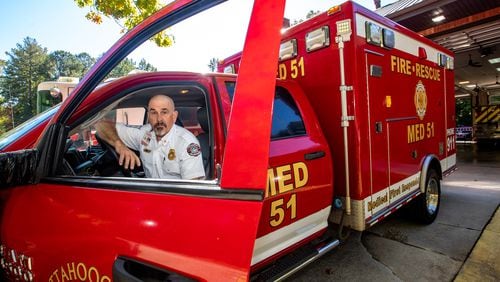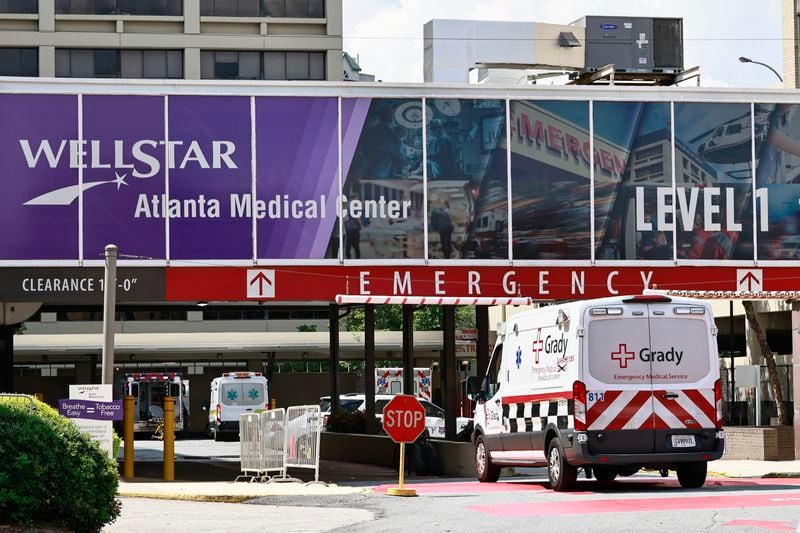In 2018, as Grady took control of ambulance service in south Fulton County, its executives promised faster service for the area’s more than 200,000 residents.
Grady assured local leaders it would do something the previous provider could not: Respond to emergency calls on average within nine minutes, the industry standard meant to ensure patients get the care they need.
Yet, Grady never met that goal.
And now, response times are so slow that ambulance service in south Fulton County has reached a crisis point. In the first half of 2022, residents in the area who dialed 911 waited an average 28 minutes for a Grady ambulance to arrive, according to county data reviewed by The Atlanta-Journal Constitution.
“If you look at national standards, 30 min response times are not acceptable,” said South Fulton City Fire Chief Chad Jones.
Grady’s ambulance struggles have collided with other strains on the metro area’s healthcare system. The May closure of Wellstar Atlanta Medical Center South in East Point has forced Grady ambulances to drive longer distances to deliver patients to increasingly crowded emergency rooms. These problems will only get worse after Wellstar Atlanta Medical Center downtown closes next month.
Compounding these issues are pandemic-related staffing and equipment shortages, which have devastated the ranks of ambulance providers in Georgia. All of it adds up to a problem with no simple fixes.
“It’s the whole system,” Jones said.
Grady officials said they are trying to address the shortage of emergency medical technicians (EMTs) and paramedics through wage increases. Grady, in a statement, also echoed the concerns of fire chiefs, who said that fewer emergency room beds in the area will increase patient wait times. While AMC is open until Nov. 1, the hospital’s emergency room has already stopped accepting ambulance patients.
“These hold times will only increase with the closure of AMC,” a Grady spokesperson said.
Capacity Issue
Grady’s entrance into south Fulton County in 2018 marked a significant new frontier for the health system’s ambulance service that had been expanding for more than a decade.
Almost from the start, Grady drew complaints from fire chiefs and EMS officials in the area, which includes East Point, College Park, the city of South Fulton, Chattahoochee Hills, Union City and Palmetto.
Credit: Natrice Miller
Credit: Natrice Miller
Officials told the AJC in 2019 that Grady had not provided enough ambulances and other resources necessary to fulfill its promises. Grady’s average response time in south Fulton was not close to the nine-minute standard.
Response times track the length of time it takes for an ambulance to arrive on scene after the initial 911 call is received. It’s a standard metric the ambulance industry uses to track performance and ensure patients with serious injuries get the care they need.
Grady was brought in because local leaders were dissatisfied with the performance of American Medical Response (AMR), which held the contract up until 2018. In its final year, AMR’s response times had crept up to roughly 14 minutes. AMR blamed overuse of the 911 system, overcrowded emergency rooms and the fact that south Fulton county had only one full-care hospital at the time: AMC South.
By 2019, Grady’s response times had become worse that AMR’s, records show.
“Every time there’s a complaint and we’re looking at whether to change providers they always say they’re going to meet the national standards and they never do,” said Fulton County commission chairman Robb Pitts.
Grady ambulances operate in 15 counties across the state, from Decatur County in the south Georgia to Fulton County in the north. Critics said its ambulance service is spread too thin. Grady executives in 2019 assured those concerned about expansion that it had helped its ability to promptly transport patients.
Things got worse after the pandemic took hold in 2020.
By 2021, a south Fulton County resident calling 911 for medical attention had a nearly one in three chance that an ambulance wasn’t immediately available to respond, according to county records.
These are known as “level zero” cases as no ambulance is available because they are all responding to other calls. Sometimes it could take seconds or minutes before one came back into service to respond, while other times it could take up to an hour.
Out of 28,700 calls for service in south Fulton that year, 10,035 had no ambulance immediately available. That’s triple the number of level zero cases throughout 2019.
A fast response is crucial if a patient is lying on the floor and not breathing, said Tom Kamplain, who operates the Georgia Institute of Emergency Medical Services, an EMS training academy in Covington
“They’re not going to survive if no one is coming,” Kamplain said.
The closure of AMC South in May, Fulton County’s only hospital with an emergency room south of I-20, has meant each month hundreds patients in the area must now be transported to hospitals further away.
In the three months leading up to the closure of AMC South’s emergency room in April, Grady ambulances transported 870 south Fulton patients to the now shuttered hospital.
The closure of AMC’s downtown emergency room means one less option. AMC and Grady have been the only Level 1 trauma centers in the Atlanta area.
Even with Governor Brian Kemp’s promised $130 million cash infusion to Grady to build an additional 185 hospital beds, many officials, including Grady Health System CEO John Haupert, see it as an imperfect fix. AMC’s closure will mean the loss of 460 hospital beds.
With fewer hospitals and lower capacity, Grady and metro healthcare officials say ambulance crews are increasingly having to idle outside emergency room entrances until there’s availability for their patients. In turn, this means fewer ambulances available to respond to medical calls, increasing response times.
When they do have to idle outside, those average wait times have increased since 2019, providers say.
“We’re looking at a capacity issue,” said Matthew Kallmyer, director of the Atlanta-Fulton County Emergency Management Agency. “The governor has made a substantial effort to shore up those needs, but there are only so many hospital beds.”
Creative Solutions
Long response times for ambulances can have a cascading effect across the emergency response system. It means fire departments feel the strain on their resources.
Firefighters often arrive to an emergency scene first to provide first aid and stabilize a patient before handing off care to an ambulance crew for transport.
Fire chiefs in south Fulton County say their crews are now waiting up to an hour for a Grady ambulance to arrive, meaning there are fewer firefighters and trucks available to go to other medical calls or fires.
“We are there, administering first aid. The firefighters are doing their job and having to wait an extended time for an ambulance,” Jones said.
Credit: city of South Fulton
Credit: city of South Fulton
Grady is working with fire chiefs in the area to try to find solutions.
The hospital system is exploring the creation of “quick response” teams that can be dispatched to relieve firefighters waiting on scene.
In addition to hourly wage increases, Grady has offered other financial incentives to attract more emergency responders, including bonuses to current employees and new recruits. Over the past several weeks, Grady has increased the number of ambulances and EMTs in the area. It’s promised even more.
“Grady EMS continues to work through industry and market challenges to respond to the needs of 911 callers,” a Grady spokesperson said in a written statement.
State Sen. John Albers, R-Roswell, isn’t sure that will be enough. Albers, who chairs the senate’s public safety committee, said the current governance system overseeing ambulance service is outdated and more control needs to be in the hands of local governments.
“Each city and county should be able to choose completely for themselves how they want to staff their EMS system, much like they staff their police and fire departments,” Albers said.
He said that a major issue is the use of 911 for non-emergency calls and he’s searching for ways to allow more flexibility in the system. He is considering bringing legislation forward when the General Assembly reconvenes in January.
But in the meantime, fire chiefs in south Fulton are having to get creative to serve their communities.
Chattahoochee Hills doesn’t have a state license to transport patients. That hasn’t stopped the city’s fire department from helping those in need. The department has used a provision in state law that makes an exception if there is not a licensed ambulance available to transport a critical patient.
Fire chief Greg Brett said his department purchased an ambulance dedicated to transporting patients who require immediate medical attention when there is no Grady ambulance available.
On Sept. 14, a woman called 911 to report a severe car crash she witnessed in Chattahoochee Hills.
“The lady that we saw lying on the floor, she’s up and walking but she’s in shock,” the caller said.
The fire department was dispatched and arrived within five minutes. They discovered one of the drivers was losing consciousness and had what appeared to be a broken arm. Firefighters and law enforcement on scene requested an ambulance three times. Each time they were told there were none available — a level zero case, records show. The firefighters decided to use the city’s ambulance to transport the injured driver to AMC downtown, records show.
“Who wouldn’t do that?” Chief Brett said. “Whether its in your own personal car or a fire engine or a dump truck or an unlicensed ambulance, who wouldn’t want to be able to take a patient as fast as they could?”
About the Author



/cloudfront-us-east-1.images.arcpublishing.com/ajc/TD742O7UHFBDTM53EKLCLE45CY.jpg)






